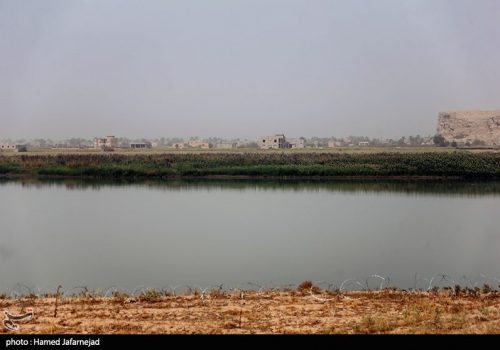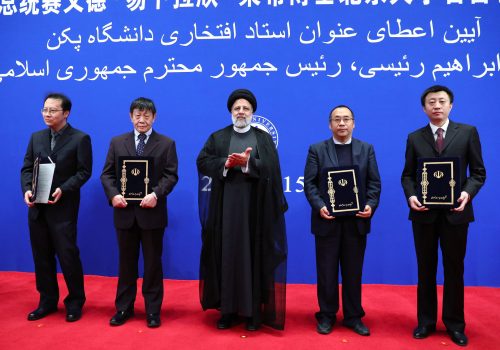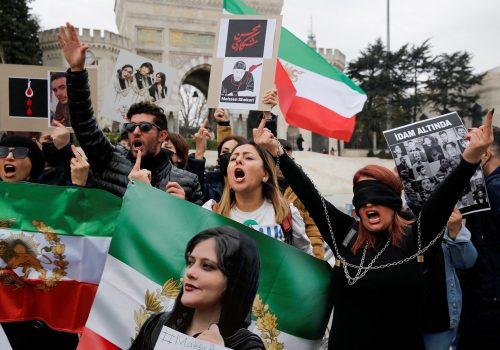Iran is still exporting oil to Hezbollah and the Assad regime. It’s using Syrian ports for transit.
The Islamic Republic was one of the first foreign powers to take advantage of the uprising to expand its presence in Syria. Since then, it has used various methods to prop up the Bashar al-Assad regime. Despite sanctions imposed on both countries, Tehran has continued to use Syrian ports—particularly the port city of Baniyas in Tartus governorates—as the main gateway to supply oil to its Lebanese proxy, Hezbollah, and its ally, the Assad regime.
It is important to understand that the oil exported by Iran to Syrian ports was not only for the Assad regime. For example, during the peak of the fuel crisis in Lebanon in 2020, Tehran supplied crude oil through the Syrian ports to Hezbollah in the last four months of 2020, and the Assad regime exercised logistics without any issues, such as assisting Hezbollah trucks in filling them with Iranian oil from Baniyas to al-Arida crossing.
Last year, Iran exported about 8 percent of its oil production through Syrian ports each quarter. China was the first importer of Iranian oil, followed by the United Arab Emirates, Syria, and Venezuela. Seventeen percent of Iran’s oil production last year was unaccounted for.
Details of Iran’s support for the Syrian regime with crude oil
Various past reports indicate that Iran concealed or falsified origin information and transported oil to Syrian ports using vessels with false registrations. A recent report published by the US Treasury Department in November 2022 indicated that Iran was exporting more oil to its sanctioned proxies and allies, such as Hezbollah and the Assad regime. The report added that the Islamic Revolutionary Guard Corps (IRGC) smuggles large shipments of oil through smuggling networks that include several key individuals and numerous front companies, as well as vessels involved in blending oil to disguise the Iranian origin of the shipments and export it around the world.
Since 2011, Iran has sought to supply the Assad regime with fuel on an almost regular basis so that it can use military means to suppress demonstrations and prevent the advance of opposition factions. However, the reimposition of US sanctions by the Donald Trump administration in 2018 forced the Islamic Republic to stop supplying oil to the Assad regime, resulting in at least a six-month fuel crisis in Syria.
But Iranian oil began to reach the Assad regime’s ports again in May 2019, when an Iranian vessel managed to deliver a shipment to the Assad regime using more stealth methods. Months later, in July 2019, the Royal Marines intercepted an Iranian oil vessel off the coast of Gibraltar that had two million barrels of crude oil on board and was on its way to the Syrian port of Baniyas. The British operation demonstrated that Iran remains eager to supply its allies with oil.
After the fighting in Syria subsided, Iran sought to consolidate its role in Syria in various sectors, including the energy sector, as evidenced by the signing of numerous agreements and projects between Iran and the Syrian regime.
In 2017, Iranian, Syrian, and Venezuelan companies agreed to develop a new oil refinery in western Homs governorate that would produce 140,000 barrels per day, with an estimated cost of $1 billion.
In the years that followed, numerous agreements were signed between Damascus and Tehran in various areas. Perhaps the most dangerous, however, was the establishment of the new telecommunications company; investigations revealed that 52 percent of the company was under the direct control of the IRGC, which is considered dangerous and worrisome because it allows Iranian intelligence services to monitor communications and gather information on various topics, including confidential energy-related issues.
In 2022, Iran supplied 8 percent of its oil production to Syria, but the entire quantity supplied was not transferred to the Assad regime. This became clear after Hezbollah Secretary-General Hassan Nasrallah’s statements in September 2021, in which he thanked Iran and the Assad regime after Tehran sent an oil vessel to the port of Baniyas, which enabled its cargo to later be transported to al-Dahieh area in Lebanon via the al-Arida border crossing (on the Syrian-Lebanese border).
Between December 2021 and December 2022, Iran sent twelve oil vessels to Syrian ports. Sources told me that six were destined exclusively for the Assad regime and another three were meant for Hezbollah. The final three were split between Hezbollah and the Assad regime. This averaged out to 35 percent for the Syrian regime and 55 percent for Hezbollah.
Israeli tactics against the IRGC emerge in the Syrian coast
In previous years, Iran avoided direct deployment and presence in Syrian coastal cities while continuing to move in limited fashion using its soft tools. This was due to the Russian presence in Syria, which was one of the key factors limiting direct Iranian deployment on the Syrian coast, thereby neutralizing the areas from Israeli strikes that increased in intensity in early 2021.
Despite the international and local political, economic, and military environment that allowed Iran to operate directly on the Syrian coast during 2022, Tehran preferred to continue its presence using various soft tools (at least during the first two quarters of 2022 in conjunction with the start of the Russian invasion of Ukraine). However, by mid-2022, Russia’s priorities changed, and its focus was placed on Ukraine. As a result, there was a decrease in logistical support for Russian forces in various Syrian regions, including the coastal governorates. This was more than enough for Iran to move more broadly and dangerously along the Syrian coast, focusing on deployment in defensive positions, key road networks, and Syrian ports, except for the port of Tartus.
It’s well known that Israel views the Iranian presence and military installations in southern Syria as a threat to its national security. Therefore, since 2013, Israel has conducted numerous airstrikes and missile strikes at times when Iranian forces have been present. These strikes have traditionally excluded coastal locations because Iran could not previously operate there.
Prior to Russia’s engagement with Ukraine, Iran attempted to position itself on the Syrian coast; its initial attempts consisted of using port depots to store medium- and long-range missiles. In September 2018, Israel targeted and destroyed Iranian warehouses in Latakia governorate near the port of Latakia.
In the beginning of 2021, there was a noticeable increase in Iranian movements observed in many coastal areas, which was confirmed by the return of direct Israeli attacks on the Syrian coast, the first of which occurred in April 2021.
The year 2022 witnessed the largest Iranian deployment to the coastal areas, which occurred in conjunction with Russia moving many of its forces to support its military operations in Ukraine. With the increase in direct Israeli attacks on Latakia and Tartus governorates, where 2022 saw the largest number of Israeli attacks on coastal areas, the following is an overview of Israeli attacks on the Syrian coast:
At the beginning of 2023, Iran found itself in a new financial crisis that was completely different from its predecessors. This is partly due to ongoing internal protests against the Islamic Republic and the high security and military costs that Iran must keep paying to cover its presence and influence in neighboring countries.
The Islamic Republic is likely to face more political and economic pressure during 2023, which could loosen its influence over regional allies, such as Syria, and force it to reevaluate its support for its said allies.
It is important to note that the economic pressure the Islamic Republic previously faced hasn’t affected Iranian PR tactics, as Iran continues to highlight its ongoing support to the Assad regime and Hezbollah. Most recently, Iranian Foreign Minister Hossein Amir-Abdollahian emphasized that the Islamic Republic continues to support the two with Iranian oil.
His announcement was published recently in some Syrian regime news agencies and several Iranian state media websites, which contradicted the Wall Street Journal’s report on January 15, pointing out Tehran’s intention to increase the price of crude oil, which it has supplied to the Assad regime in recent years at a symbolic price.
The manner in which the Assad regime and Islamic Republic handled the information from the report was to be expected. Nevertheless, the events of 2022 and of this year might eventually force Tehran to reevaluate its priorities, such as the one that has it exporting free oil to Assad and Hezbollah.
Navvar Saban is a conflict expert at the Omran Center for Strategic Studies, where he specializes in Iranian influence in Syria, focusing on Shia militia activity. He is also a non-resident researcher at the Orsam Center. Follow him on Twitter: @NavvarSaban.
Further reading
Mon, Oct 28, 2019
A highway linking Iraq and Syria becomes an opportunity for Tehran
MENASource By
In the past month, the sands have shifted within the Levant’s political landscape. The United States has recalibrated its official policy in the region, choosing to draw down its special operations forces in northern Syria and thereby introducing a power vacuum in the region. After an offensive and brief ceasefire in northern Syria, Moscow and Ankara […]
Wed, Feb 22, 2023
Iran’s economic future is uncertain. It’s no surprise why Raisi visited China.
IranSource By Jonathan Fulton
From February 14-16, Iranian President Ebrahim Raisi was in Beijing for his first foreign trip of the year and the first official visit to China for an Iranian leader in twenty years.
Thu, Dec 22, 2022
I’m a former Syrian civil society activist. Syrians can’t tell Iranians how to win, but we can share lessons we learned the hard way.
IranSource By
Be the Iran you want to see.
Image: The oil supertanker Grace 1, that's on suspicion of carrying Iranian crude oil to Syria, sits anchored in waters of the British overseas territory of Gibraltar, historically claimed by Spain, July 4, 2019. REUTERS/Jon Nazca


